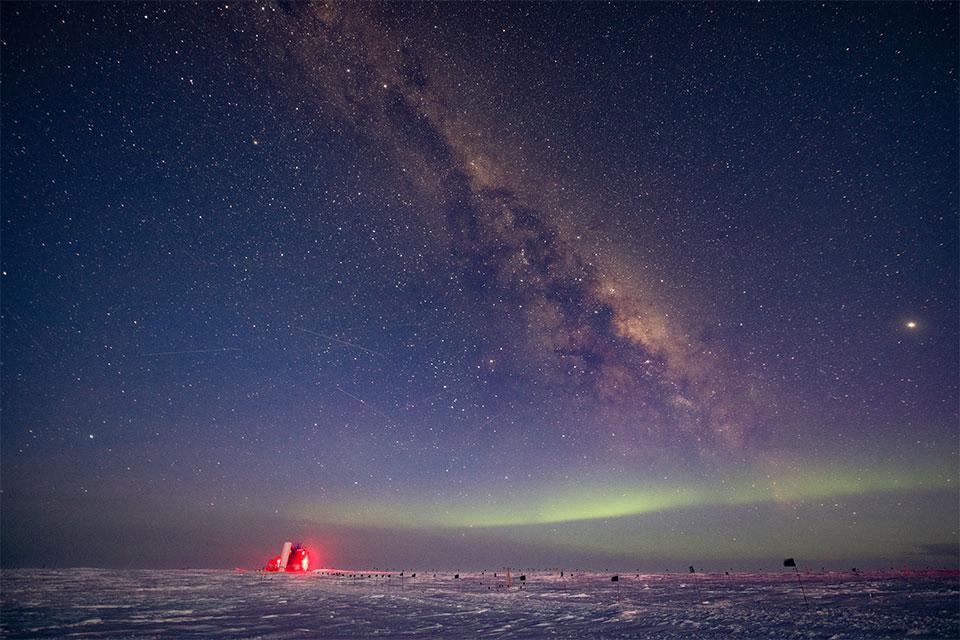On 8 December 2016, an electron antineutrino with an energy of 6300 TeV hurtled to Earth from a cosmic accelerator. Deep inside the ice sheet at the South Pole, it smashed into an electron and produced a massive particle that quickly decayed. This interaction was captured by a kilometre-sized 'telescope' buried in the Antarctic glacier – the IceCube Neutrino Observatory.
That particle was the W- gauge boson which mediates radioactive (beta) decay and the mass of which was precisely predicted to be 80.379 GeV by the unified theory of the electromagnetic and weak interactions that we call today the 'Standard Model'. To create W- bosons in the laboratory required smashing protons and antiprotons together at the highest energy of 450 GeV that the Super Proton Synchrotron accelerator in Geneva was capable of in 1983. This earned CERN physicists their first Nobel prize.
Enormous energies
Sheldon Glashow, who received the prize in 1979 for his part in constructing the Standard Model, had discussed much earlier another way to create a W- boson. He noted that the inverse process to beta decay can be initiated by an electron antineutrino hitting an electron and that this is a resonance when the incident neutrino energy is just high enough to create the W- boson 'on shell'. In 1960, the W- was believed to be no heavier than the proton, so his estimate for the required antineutrino energy was as low as 0.9 TeV. In fact, the W- is over 80 times heavier, so the antineutrino needs 6300 TeV of energy – 900 times higher than the beams now produced at the Large Hadron Collider. The enormous energies of supermassive black holes at the centres of galaxies and other extreme cosmic events can however somehow accelerate particles to energies impossible to create on Earth. Such a phenomenon was likely responsible for the antineutrino that created the 'Glashow resonance' event observed in IceCube.
This provides yet another confirmation of the Standard Model of particle physics. It also demonstrates the ability of IceCube, which opened a new window on the universe with the discovery of cosmic high-energy neutrinos in 2013 and the identification of the first astrophysical high-energy neutrino source in 2017 – to also investigate fundamental particle physics. Since starting full operation in May 2011, the observatory has detected hundreds of astrophysical neutrinos, as well as hundreds of thousands of neutrinos made by cosmic rays in the Earth’s atmosphere. This has enabled it to make measurements of neutrino oscillations with precision comparable to terrestrial accelerator-based experiments, and probe ultrahigh energy interactions which are sensitive to new physics beyond the Standard Model.
Neutrino astronomy
'Previous measurements have not been sensitive to the difference between neutrinos and antineutrinos, so this is the first direct measurement of an antineutrino component of the astrophysical neutrino flux,' says Lu Lu, one of the main analysers of this paper, who was a postdoc at Chiba University in Japan during the analysis. Tianlu Yuan, an assistant scientist at the Wisconsin IceCube Particle Astrophysics Center and another main analyser notes further: 'There are a number of properties of the astrophysical neutrinos' sources that we cannot measure, like the physical size of the accelerator and the magnetic field strength in the acceleration regions… if we can determine the neutrino-to-antineutrino ratio, we can directly investigate these properties.' Christian Haack, who was a graduate student at RWTH Aachen while working on this analysis comments: 'This result proves the feasibility of neutrino astronomy — and IceCube’s ability to do it — which will play an important role in future multi-messenger astroparticle physics.'
To confirm the detection and make a decisive measurement of the neutrino-to-antineutrino ratio, the IceCube Collaboration wants to see more Glashow resonances. A proposed expansion of the IceCube detector, IceCube-Gen2, would enable the scientists to make such measurements in a statistically significant way. The collaboration recently announced an upgrade of the detector that will be implemented over the next few years, the first step toward IceCube-Gen2. Glashow, now an emeritus professor of physics at Boston University, echoes the need for more detections of Glashow resonance events. 'To be absolutely sure, we should see another such event at the very same energy as the one that was seen,' he says. 'So far there’s one, and someday there will be more.'
IceCube: an international collaboration
IceCube is operated by more than 400 scientists and engineers from 53 institutions in 12 countries. In the UK, the University of Oxford is the only full member of the collaboration (Neutrinos in the deep freeze, 19 Oct 2010). Professor Subir Sarkar in the Rudolf Peierls Centre for Theoretical Physics has been the institution lead since 2004 when the collaboration was formed and shared in the recent award to IceCube of the American Astronomical Society 2021 Bruno Rossi Prize. A key contribution from Oxford has been the input to the data analyses of a precise calculation of the probability of high energy neutrino interactions – based on measurements of parton distribution functions by his experimental colleagues in Oxford Particle Physics (Antarctic telescope shows how the Earth stops high energy particles, 23 Nov 2017). Oxford astrophysicists are also now using IceCube data to do multi-messenger astronomy (Scientists uncover cosmic particle accelerator, 22 Feb 2021). 'The benefits of such inter-disciplinary collaborations to advance our understanding of the universe could not be clearer,' concludes Professor Sarkar.
Detection of a particle shower at the Glashow resonance with IceCube, IceCube collaboration: R. Abbasi et al. Nature, 591 (2021) 220-224

